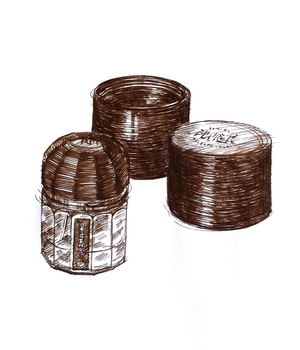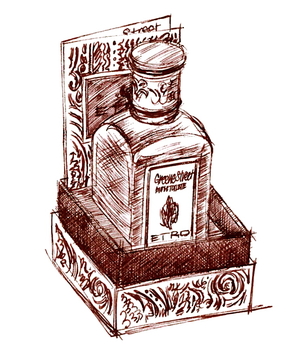Tagged With ‘1970s’
Ramón Monegal
Dry Wood
2 March, 2015
 The world of perfume is full of great stories – some of them true, others completely bogus or quietly tweaked by fiendish marketeers. The story of Ramón Monegal is one of the better ones, and it’s also more interesting than most. The nice thing is that it has a happy ending too.
The world of perfume is full of great stories – some of them true, others completely bogus or quietly tweaked by fiendish marketeers. The story of Ramón Monegal is one of the better ones, and it’s also more interesting than most. The nice thing is that it has a happy ending too.
Monegal’s great-grandfather founded Myrurgia, which during the twentieth century became the best-known perfume brand in Spain. Ramón joined the business in 1972, training at Firmenich in Geneva and in Paris with the famous perfumer Pierre Bourdon (creator of Davidoff’s Cool Water and Serge Lutens’ Feminité du Bois).
Ramón created his first perfume for Myrurgia in 1979, but he also went on to develop scents for other brands, from Adolfo Dominguez to Inès de la Fressange. He eventually became vice-president of the family company, but in 2000 it was sold to Puig, the giant Barcelona-based fragrance-and-fashion group, which owns everything from Jean-Paul Gaultier to Penhaligon’s and L’Artisan Parfumeur.
The transition from owner to employee is surely always a difficult one, and though Monegal was appointed development director for the group’s fragrance brands, it must have hurt when, in 2007, Puig closed Myrurgia down. Monegal left the same year, but in 2010 he launched his own brand, and in 2014 he made a remarkable comeback by releasing fourteen new fragrances in one go. All the ones I’ve smelled so far are interesting and unusual, and Dry Wood is no exception.
It’s been described as a ‘sharp sandalwood’, but it also reminds me of a top-quality men’s aftershave from the 1970s, with hints of cedar and pine as well as sandalwood; if you remember the old ‘things happen after a Badedas bath’ adverts you’ll know the kind of thing I mean. It has great staying-power, and after a while smells woodier than it does to start with, though still with a touch of pine and turpentine.
Like all the perfumes in the range, Dry Wood comes in attractively luxurious packaging, also designed by Monegal. The chunky twelve-sided ‘inkwell’ bottles, with their flip-up black domed caps, are apparently inspired by his love of literature, and are contained in black Bakelite tubes, which screw closed in a very satisfying way. Perhaps it’s not surprising that these perfumes are expensive, at £130 for just 50ml (or $160 in the States).
The only problem at the moment is buying them: currently they’re only available from Harrods in the UK or Nieman Marcus in the US, which means they’re not going to get as wide an exposure as I think they deserve. Still, they’re well worth tracking down if you have the dedication (and the cash).
Etro
Greene Street
26 April, 2014
 The Italian fashion brand Etro made its name with a neo-hippy mix of paisley prints and clashing colours, so it’s no surprise that, among the 25-odd perfumes they’ve released since 1989, there’s the occasional whiff of patchouli and joss-sticks.
The Italian fashion brand Etro made its name with a neo-hippy mix of paisley prints and clashing colours, so it’s no surprise that, among the 25-odd perfumes they’ve released since 1989, there’s the occasional whiff of patchouli and joss-sticks.
Their latest nod in that direction is Greene Street, launched in 2012 to coincide with the opening of their second Manhattan boutique on – you’ve guessed it – Greene Street in SoHo. According to Etro, ‘the western bohemian spirit is the heartbeat of the quarter’, though given that near neighbours include Chanel and Marc Jacobs, Etro’s idea of bohemian may be rather different from yours and mine.
As for the perfume, here’s what they say about it: ‘A symphony of spices create the perfect scent for the modern cosmopolitan man, for those who follow fashion but add their own unique touch of personality to every look. Versatile and distinctive, this perfume also magically adapts a more feminine tone when worn by a woman, thanks to the seductive subtle undertones.’
Got that? Personally I think it smells a bit like that old Body Shop hit from the 1980s, Dewberry, with its slightly choke-inducing mixture of spice and fruitiness. In Greene Street’s case, the scent ingredients include pepper (specifically the ‘pink pepper’ that, in the perfume world, has been so puzzlingly fashionable for the last few years), underpinned with nutmeg, violet and incense, among other things.
I’ve no idea which perfumer created Greene Street, though I see that a number of Etro’s previous fragrances were put together by the French perfume company Robertet; maybe one day we’ll be told, but there again they may be perfectly happy to remain anonymous.
It’s not a horrible perfume, which instantly sets it above most of its competitors on department-store shelves around the world, but neither can I see it becoming one of my favourites. Which is a shame, as much as anything because I think that Greene Street is particularly well packaged and presented.
I haven’t, up to now, included packaging when I’ve illustrated a perfume, but I like this box so much, with its abstract paisley design on the outside and purple inner lining, that I think it’s worth a mention – not least because storing perfumes in their boxes is so much better for them than exposing them to light, and really well-designed packaging is a great encouragement on that front. So two cheers for retro Etro.